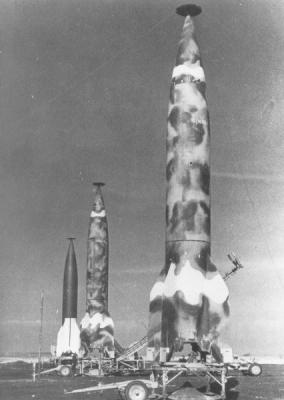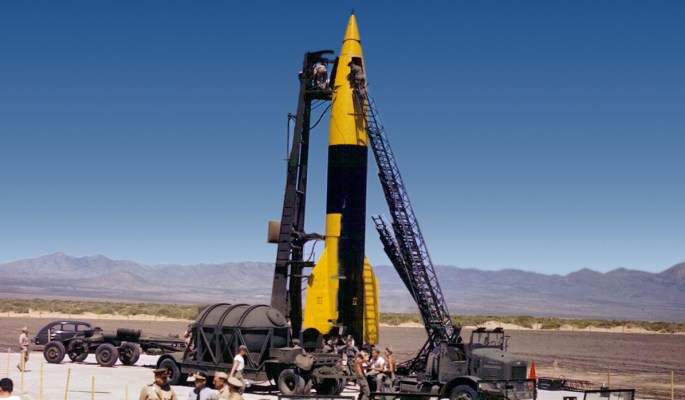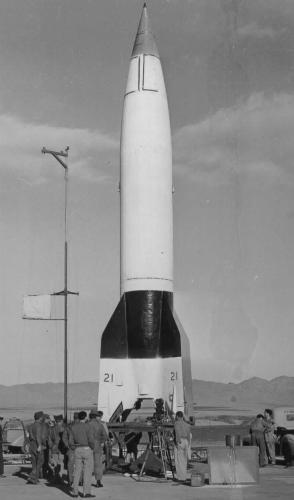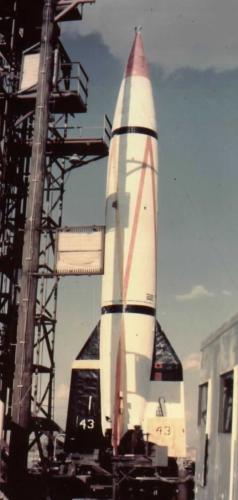V-2 (A-4)
The German Army's A-4 rocket was the world's first long-range strategic missile, and a major technological breakthrough in the development of large rockets. It is included in the Directory of U.S. Military Rockets and Missiles, because it was extensively used after the 2nd World War in the USA (as well as in other countries) as a high-altitude sounding rocket and general rocket research tool. To put the American usage of the rocket in proper context, the history of the A-4 as a German surface-to-surface missile has to be briefly sketched in this article as well.
A-4/V-2 in Germany
The German Army's rocket program dates back to 1929, when alternatives to conventional long-range artillery were sought to work around limitations imposed by the Versailles Treaty. In an Army installation eventually known as Heeresversuchsanstalt Peenemünde (HVP), Wernher von Braun and others designed and tested a series of rockets known as A-1 through A-3 (A = Aggregat). Design work for the military A-4 rocket had already begun by 1937, but setbacks necessitated tests with an experimental A-5 vehicle. After a series of failures, the first successful A-4 launch eventually occurred on 3 October 1942. The A-4 missile received the propaganda designation V-2 (V = Vergeltungswaffe = Vengeance Weapon), and under that name the rocket would become (in-)famous.
The V-2 was powered by a rocket engine burning liquid oxygen and alcohol. This engine was much larger than any other built so far, and remained the most powerful rocket engine for some years after the war. It also pioneered the use of turbo-pumps to pressure-feed the propellants into the rocket's combustion chamber. The V-2 was transported horizontally on a mobile trailer/launcher, but was raised to the vertical before fuelling and launch. For launch, the engine was first ignited at reduced power to ensure that it was working properly, and the V-2 didn't lift-off until the fuel turbo-pumps were started to achieve full thrust. The V-2 didn't have a mid-course or terminal guidance system. To hit a specific target, the engine was cut-off at a predetermined heading, speed and altitude, and the missile then followed a ballistic course until impact. Initially, the engine cut-off signal was transmitted by radio, but later an autonomous system was devised, which used an integrating accelerometer to compute the moment when the preset cut-off velocity had been reached. To prevent disturbance of the ballistic trajectory by roll, pitch and yaw errors, the V-2 was equipped a gyroscopic system, which corrected any course deviations. The missile was steered using deflection vanes in the rocket exhaust and movable control surfaces on the tail fins. The V-2's nose cone contained almost 975 kg (2150 lb) of high explosive, which detonated on impact. Maximum range was about 320 km (200 miles), but the crude aiming system meant that impact errors of several kilometers were common.
 |
| Photo: via The A-4/V-2 Resource Site |
| V-2 (A-4) |
Mass firings of V-2s against allied cities began in September 1944, and until the end of the war more than 3200 missiles had been fired by the Germans. Although without doubt a significant technological achievement, the V-2 was actually a failure as a military tool. Its production required far too much rare resources when compared to the damage inflicted by its use. Furthermore, the lack of accuracy meant that it could only be used against large area targets (i.e. cities), making it a pure terror weapon against civilians and unsuitable to hit anything of military value (except by chance, of course).
Personal note by the author: The A-4/V-2 is usually regarded as a great engineering achievement. That its firings killed thousands of civilians might be "excused" by the fact that it was wartime, and that any technological developments at that time were only possible if they had a military use. However, what in my view forever forbids the A-4 a place in a "Hall of Fame" of mankind's inventions are the circumstances of its mass production. This was done in the so-called Mittelwerke, a large underground facility near Nordhausen. More than 20000 people died there while working under unbelievably horrible conditions (way beyond anything that could be regarded as "normal" for slave workers). These workers were regarded by the Nazis not even as slaves (which do have at least some value to their "owners") but as pure "throw-away tools". If one "breaks", throw it away and get a new one at no cost. In my opinion, any historical work on the A-4/V-2 rocket, which doesn't mention the conditions at the Mittelwerke, is incomplete.
A-4/V-2 in the USA
After the war, the U.S. Army brought von Braun and his team, as well as V-2 parts to assemble about 100 rockets, to the United States. The rocket's advanced technology was to be thoroughly studied to provide the U.S. military's post-war missile programs a jump start. Prime contractor for the Army's V-2 program was General Electric, which managed V-2 activities within the overall Hermes effort. The first launch attempt of a V-2 at White Sands Proving Ground (later White Sands Missile Range) failed on 16 April 1946, but the next attempt on 10 May was successful.
 |
| Photo: Martin Sauber |
| V-2 (A-4) |
The performance of the V-2 was much higher than that of any other then available rocket, and it became therefore immediately interesting to scientists who wanted to study high-altitude and near-earth space phenomena. Furthermore, after the removal of the warhead the rocket's nose had to be filled with about one ton of material anyway, and this could just as well be used for scientific experiments. Until September 1952, a total of 64 V-2s firings were conducted with all sorts of military and civilian payloads. One launch in December 1946, which had reached an altitude of 187 km (116 miles), achieved the absolute altitude record for single-stage rockets until it was surpassed by a RTV-N-12 Viking on 7 August 1951. The highest altitude ever reached by a V-2 were the 213 km (132.6 miles) of flight TF-1 on 22 August 1951. One V-2 was fired from the deck of the U.S. Navy aircraft carrier USS Midway to evaluate the possibility of launching large guided missiles from such ships.
 |
 | |
| Photos: National Air & Space Museum | ||
| V-2 (A-4) | ||
Although the V-2 was a very useful research tool, it had some significant drawbacks as a general-purpose high-altitude sounding rocket. First, the payload capacity was much larger than needed for most scientific experiments. Therefore often many different payloads were packed into one flight, frequently leading to unwanted interference. Also, a single launch failure meant that several experiments were lost. Additionally, the V-2 nose cone had no built-in capability to recover the payload. In most cases, results were either directly telemetered to the ground during the flight, or it was simply hoped that the payload would survive the final impact (somewhat slowed by "tumbling" the rocket on descent) in a useable state. When the Aerobee, a small purpose-designed sounding rocket, became available in 1948, the V-2's use for such purposes became limited to payloads which really needed the missile's large power.
The V-2 was also used as the vehicle for the RTV-G-3 Hermes II tests, and as the first stage of the world's first two-stage rocket, the RTV-G-4 Bumper.
Specifications
Note: Data given by several sources show slight variations. Figures given below may therefore be inaccurate!
Data for V-2 (A-4) (as sounding rocket):
| Length | 14.03 m (46 ft 0.3 in) |
| Finspan | 3.56 m (11 ft 8 in) |
| Diameter | 1.65 m (5 ft 5 in) |
| Weight | 13000 kg (28700 lb) |
| Speed | 5580 km/h (3470 mph) |
| Altitude | > 160 km (100 miles) |
| Propulsion | Liquid-fueled rocket; 267 kN (60000 lb) for 70 s |
Main Sources
[1] J.R. Smith, Antony Kay: "German Aircraft of the Second World War", Putnam, 1972
[2] Peter Alway: "Rockets of the World", Saturn Press, 1999
Back to Directory of U.S. Military Rockets and Missiles, Appendix 4
Last Updated: 4 October 2005